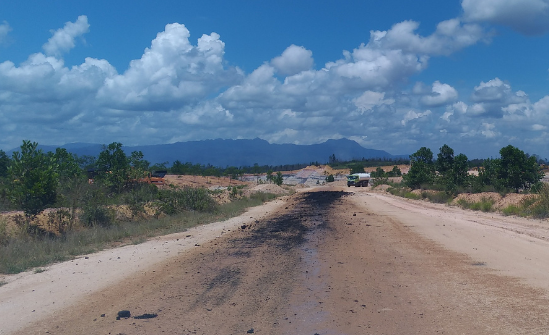By Derf Johnson
Astronomical profits are motivating coal corporations to increase their export capacity in order to take advantage of a lucrative Asian market. The Powder River Basin in southeastern Montana and northern Wyoming — the largest source of coal burned for electricity in the United States — is no exception. Montana mines in this region include the Bull Mountain mine and the Spring Creek mine, which currently export a large volume of their coal to international markets, primarily through Canadian ports. Now, the Navajo Transitional Energy Company (NTEC) is looking to further capitalize on a large and profitable export market by building out a new Wyoming mine, and the Montana Department of Environmental Quality (DEQ) is willing to pave the way, our climate be damned.

Currently, coal mining corporations are making profits hand-over-fist on the international market and are looking at every avenue possible to increase sales and double down on revenue. Much of this is due to a growing demand for coal in Asia and, in particular, China. According to the Energy Information Administration, a coal exporter in 2022 could expect upwards of $115 per ton for exports to Asian markets, whereas domestic sales were approximately $34 per ton, a 240% difference in price.
Following the bankruptcy of Cloud Peak Energy in 2019, NTEC acquired a number of Cloud Peak assets, including the Spring Creek coal mine in Montana as well as the Antelope and Cordero Rojo mines in Wyoming. NTEC also acquired the Youngs Creek mine, a proposed and fully permitted Wyoming coal mine right on the Montana border that has not yet broken ground. Mining tens of millions of coal tonnage annually at Youngs Creek has been a dream of the coal industry since the late 1970s, but the limiting factor in its viability appears to primarily be that the transportation component of exporting the coal has proven difficult. Now that NTEC is on the scene and massive profits are on the horizon, there is a renewed interest in developing Youngs Creek, and the Montana DEQ is complicit in the plan.
Rather than build out existing rail infrastructure to Youngs Creek, which comes at high capital costs, NTEC is now on a path to building a coal “haul road,” which will allow for massive, 240-ton trucks to haul coal on nine miles of road in Montana from Youngs Creek to Spring Creek, where NTEC could take advantage of existing railroad infrastructure to export the coal. To be clear, these massive trucks will make approximately 130 trips every day, seven days per week, 365 days per year.
In addition to facilitating a carbon bomb and adding more coal to Montana’s coal-choked railways, the road would cut directly through prime sage grouse habitat and destroy several lek sites in the process.
NTEC’s predecessor Cloud Peak originally applied to the Montana DEQ for a permit to build the haul road in December 2015. In summer 2018, DEQ issued a draft environmental impact statement (EIS) which was intended to evaluate the myriad environmental issues associated with the construction of the haul road. However, noticeably absent was any evaluation of the carbon emissions that would result from Montana facilitating and enabling new coal mine in Wyoming. MEIC submitted comments in 2018 on the draft EIS, urging the agency to account for or consider carbon emissions in its evaluation. Those requests were ignored, but the application then went dormant.

After the application sat for five long years, DEQ suddenly deemed the haul road application “acceptable” August 11 and issued a final EIS. The acceptability determination is one of the final steps for approval of a coal mine permit and includes a short comment period for the public. Most importantly, the final EIS specifically refused to analyze climate impacts, citing the laws passed just months prior during the 2023 Montana Legislature, which specifically prohibited the DEQ from considering climate impacts in its environmental analyses.
DEQ’s timing is impeccable. Just four days after the acceptability determination and final EIS were issued, the groundbreaking case Held v. State of Montana was released, where a district court judge ruled that the State of Montana has a duty to consider climate impacts when conducting an EIS process. The judge further ruled that the law passed in 2023 that prohibited the state from considering climate change was unconstitutional and could not be enforced. MEIC subsequently submitted comments on DEQ’s acceptability determination and final EIS, noting that the laws were now invalid, that DEQ had a responsibility and an obligation to analyze climate impacts, and that it was still required to do so through a supplemental EIS as the agency had not reached a final decision.
Rather than conduct what is legally required, DEQ shirked off our concerns and issued a final approval of the haul road to NTEC on September 26. The approval of the haul road was NTEC’s last hurdle to mine up to 291 million tons of recoverable coal from Youngs Creek, haul it by truck to Spring Creek, and export it to power plants across the world where it will be fed into boilers that destroy our climate. 291 million tons of coal is massive, representing more than half of all of the coal burned in the United States in 2022 for electricity (513 million tons). The thought that the Montana Department of Environmental Quality is not just complicit in this plan, but is refusing to analyze climate change impacts in the year 2023 – even after a judge has ordered it to do so – is shocking and appalling. Watch this space, as there’s a good chance we’re going to hold the DEQ to account for this morass.
This article was published in the December 2023 issue of Down To Earth.

